2015 NISSAN GT-R warning light
[x] Cancel search: warning lightPage 60 of 358
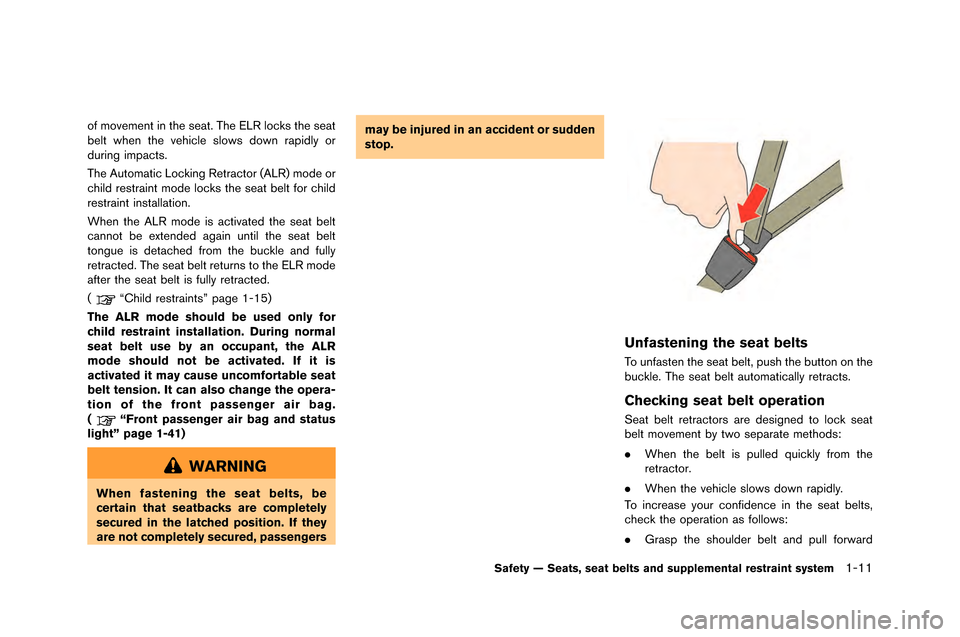
of movement in the seat. The ELR locks the seat
�felt when the vehicle slows down ra�bidly or
during im�bacts.
The Automatic Locking Retractor (ALR) mode or
child restraint mode locks the seat �felt for child
restraint installation.
When the ALR mode is activated the seat �felt
cannot �fe extended again until the seat �felt
tongue is detached from the �fuckle and fully
retracted. The seat �felt returns to the ELR mode
after the seat �felt is fully retracted.
(
“Child restraints” �bage 1-15)
The ALR mode should be used only for
child restraint installation. During normal
seat belt use by an occupant, the ALR
mode should not be activated. If it is
activated it may cause uncomfortable seat
belt tension. It can also change the opera-
tion of the front passenger air bag.
(
“Front passenger air bag and status
light” page 1-41)
WARNING
When fastening the seat belts, be
certain that seatbacks are completely
secured in the latched position. If they
are not completely secured, passengers may be injured in an accident or sudden
stop.
Unfastening the seat belts
To unfasten the seat �felt, �bush the �futton on the
�fuckle. The seat �felt automatically retracts.
Checking seat belt operation
Seat �felt retractors are designed to lock seat
�felt movement �fy two se�barate methods:
.
When the �felt is �bulled quickly from the
retractor.
. When the vehicle slows down ra�bidly.
To increase your confidence in the seat �felts,
check the o�beration as follows:
. Gras�b the shoulder �felt and �bull forward
Safety — Seats, seat belts and supplemental restraint system1-11
Page 70 of 358

5. Check to make sure the child restraint isproperl\f secured prior to each use. If the
child restraint is loose, repeat steps \b
through 4.
REAR-FACING CHILD RESTRAINT
INSTALLATION USING THE SEAT
BELTS
WARNING
The three-point seat belt with Auto-
matic Locking Retractor (ALR) must be
used when installing a child restraint.
Failure to use the ALR mode will result
in the child restraint not being properly
secured. The restraint could tip over or
be loose and cause injury to a child in a
sudden stop or collision. Also, it can change the operation of the front
passenger air bag. See “Front passen-
ger air bag and status light” later in this
section.
Safety — Seats, seat belts and supplemental restraint system\b-2\b
Page 76 of 358
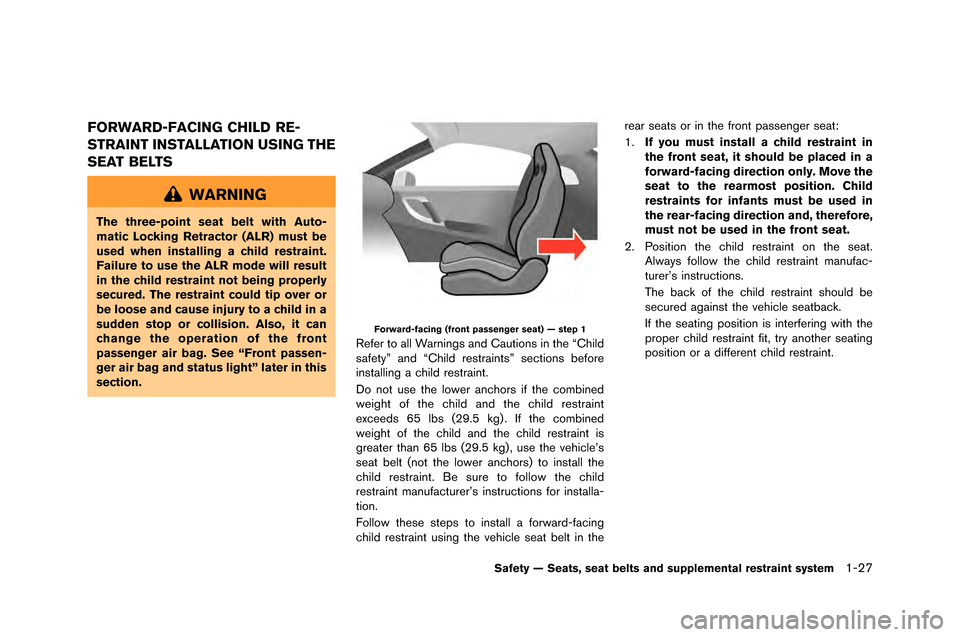
FORWARD-FACING CHILD RE-
STRAINT INSTALLATION USING THE
SEAT BELTS
WARNING
The three-point seat belt with Auto-
matic Locking Retractor (ALR) must be
used when installing a child restraint.
Failure to use the ALR mode will result
in the child restraint not being properly
secured. The restraint could tip over or
be loose and cause injury to a child in a
sudden stop or collision. Also, it can
change the operation of the front
passenger air bag. See “Front passen-
ger air bag and status light” later in this
section.
Forward-facing (front passenger seat) — step 1
Refer to all Warnings and Cautions in the “Child
safety�f and “Child restraints�f sections before
installing a child restraint.
�bo not use the lower anchors if the combined
weight of the child and the child restraint
exceeds 65 lbs (29.5 kg) . If the combined
weight of the child and the child restraint is
greater than 65 lbs (29.5 kg) , use the vehicle’s
seat belt (not the lower anchors) to install the
child restraint. Be sure to follow the child
restraint manufacturer’s instructions for installa-
tion.
Follow these steps to install a forward-facing
child restraint using the vehicle seat belt in therear seats or in the front passenger seat:
1.
If you must install a child restraint in
the front seat, it should be placed in a
forward-facing direction only. Move the
seat to the rearmost position. Child
restraints for infants must be used in
the rear-facing direction and, therefore,
must not be used in the front seat.
2. Position the child restraint on the seat. Always follow the child restraint manufac-
turer’s instructions.
The back of the child restraint should be
secured against the vehicle seatback.
If the seating position is interfering with the
proper child restraint fit, try another seating
position or a different child restraint.
Safety — Seats, seat belts and supplemental restraint system1-27
Page 79 of 358
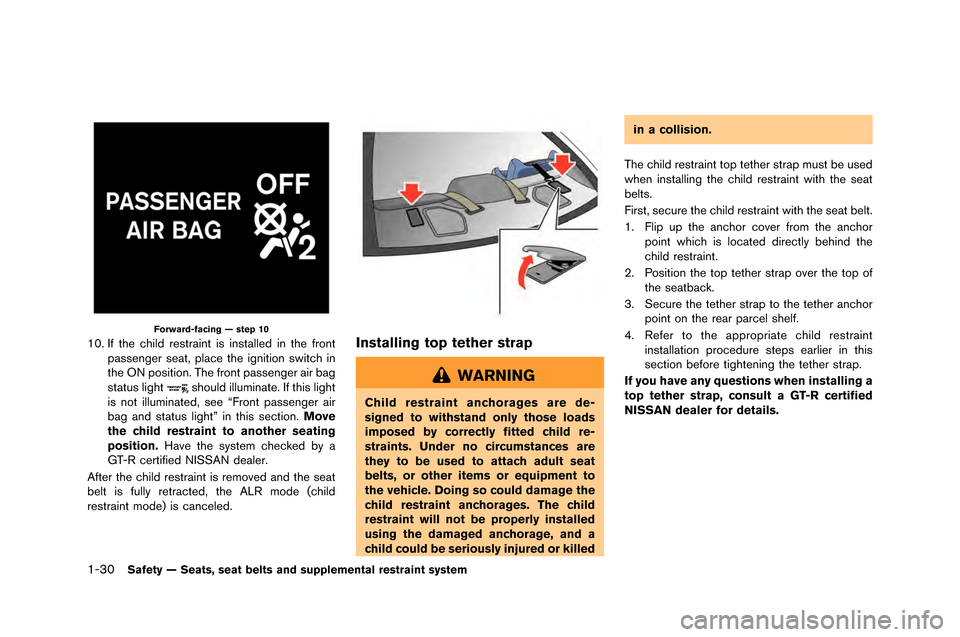
1-30Safety — Seats, seat belts and supplemental restraint system
Forward-facing — step 10
10. If the child restraint is installed in the front�fassenger seat, �flace the ignition switch in
the �bN �fosition. The front �fassenger air bag
status light
should illuminate. If this light
is not illuminated, see “Front �fassenger air
bag and status light” in this section. Move
the child restraint to another seating
position. Have the system checked by a
GT-R certified NISSAN dealer.
After the child restraint is removed and the seat
belt is fully retracted, the ALR mode (child
restraint mode) is canceled.
Installing top tether strap
WARNING
Child restraint anchorages are de-
signed to withstand only those loads
imposed by correctly fitted child re-
straints. Under no circumstances are
they to be used to attach adult seat
belts, or other items or equipment to
the vehicle. Doing so could damage the
child restraint anchorages. The child
restraint will not be properly installed
using the damaged anchorage, and a
child could be seriously injured or killed in a collision.
The child restraint to�f tether stra�f must be used
when installing the child restraint with the seat
belts.
First, secure the child restraint with the seat belt.
1. Fli�f u�f the anchor cover from the anchor �foint which is located directly behind the
child restraint.
2. Position the to�f tether stra�f over the to�f of the seatback.
3. Secure the tether stra�f to the tether anchor �foint on the rear �farcel shelf.
4. Refer to the a�f�fro�friate child restraint installation �frocedure ste�fs earlier in this
section before tightening the tether stra�f.
If you have any questions when installing a
top tether strap, consult a GT-R certified
NISSAN dealer for details.
Page 83 of 358
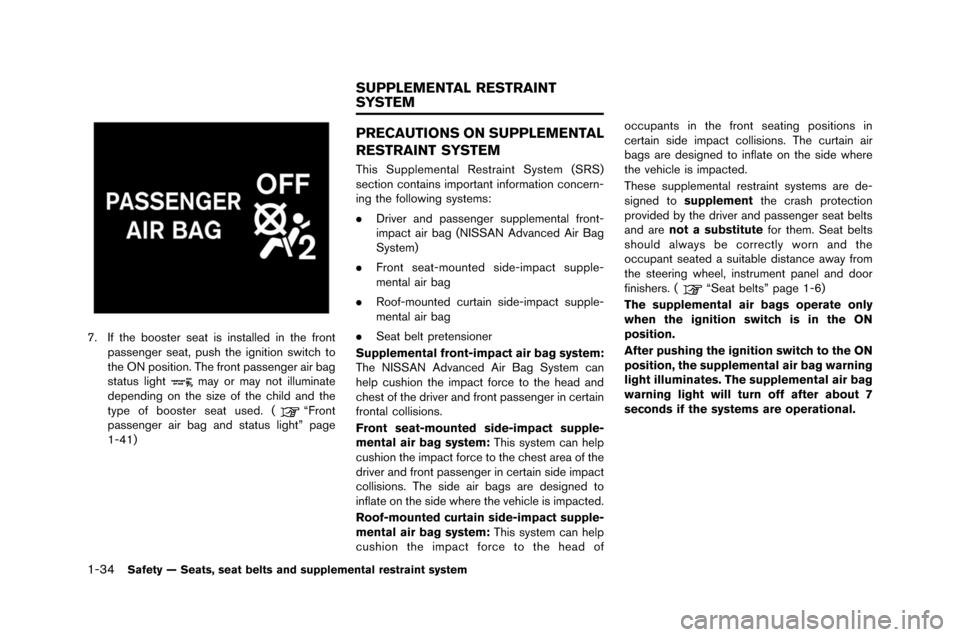
1-34Safety — Seats, seat belts and supplemental restraint system
7. If the booster seat is installe�f in the frontpassenger seat, p�bsh the ignition switch to
the ON position. The front passenger air bag
stat�bs light
may or may not ill�bminate
�fepen�fing on the size of the chil�f an�f the
type of booster seat �bse�f. (
“Front
passenger air bag an�f stat�bs light” page
1-41)
PRECAUTIONS ON SUPPLEMENTAL
RESTRAINT SYSTEM
This S�bpplemental Restraint System (SRS)
section contains important information concern-
ing the following systems:
. Driver an�f passenger s�bpplemental front-
impact air bag (NISSAN A�fvance�f Air Bag
System)
. Front seat-mo�bnte�f si�fe-impact s�bpple-
mental air bag
. Roof-mo�bnte�f c�brtain si�fe-impact s�bpple-
mental air bag
. Seat belt pretensioner
Supplemental front-impact air bag system:
The NISSAN A�fvance�f Air Bag System can
help c�bshion the impact force to the hea�f an�f
chest of the �friver an�f front passenger in certain
frontal collisions.
Front seat-mounted side-impact supple-
mental air bag system: This system can help
c�bshion the impact force to the chest area of the
�friver an�f front passenger in certain si�fe impact
collisions. The si�fe air bags are �fesigne�f to
inflate on the si�fe where the vehicle is impacte�f.
Roof-mounted curtain side-impact supple-
mental air bag system: This system can help
c�bshion the impact force to the hea�f of occ�bpants in the front seating positions in
certain si�fe impact collisions. The c�brtain air
bags are �fesigne�f to inflate on the si�fe where
the vehicle is impacte�f.
These s�bpplemental restraint systems are �fe-
signe�f to
supplement the crash protection
provi�fe�f by the �friver an�f passenger seat belts
an�f are not a substitute for them. Seat belts
sho�bl�f always be correctly worn an�f the
occ�bpant seate�f a s�bitable �fistance away from
the steering wheel, instr�bment panel an�f �foor
finishers. (
“Seat belts” page 1-6)
The supplemental air bags operate only
when the ignition switch is in the ON
position.
After pushing the ignition switch to the ON
position, the supplemental air bag warning
light illuminates. The supplemental air bag
warning light will turn off after about 7
seconds if the systems are operational.
SUPPLEMENTAL RESTRAINT
SYSTEM
Page 84 of 358
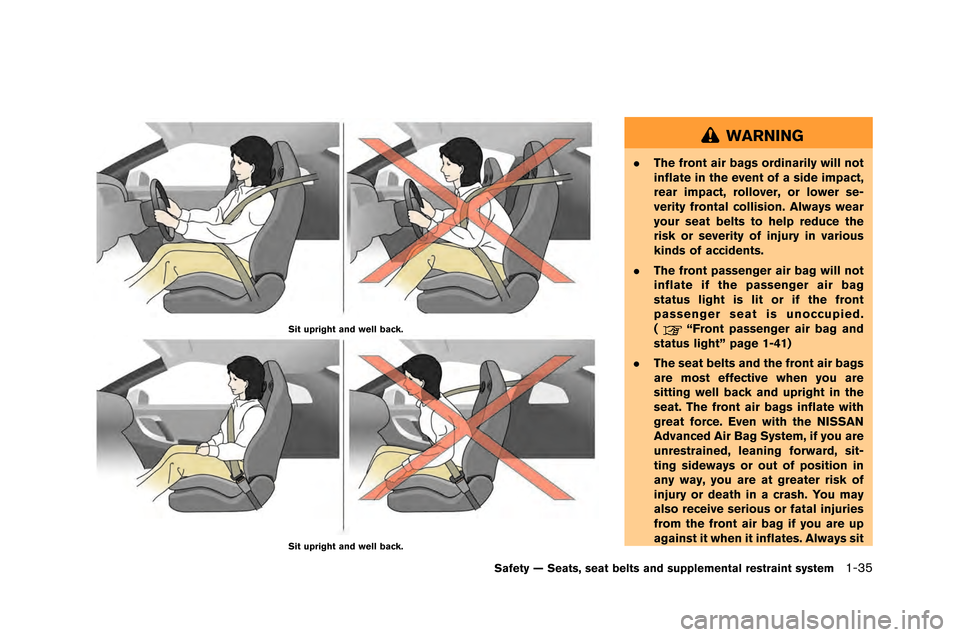
Sit upright and well back.
Sit upright and well back.
WARNING
.The front air bags ordinarily will not
inflate in the event of a side impact,
rear impact, rollover, or lower se-
verity frontal collision. Always wear
your seat belts to help reduce the
risk or severity of injury in various
kinds of accidents.
. The front passenger air bag will not
inflate if the passenger air bag
status light is lit or if the front
passenger seat is unoccupied.
(
“Front passenger air bag and
status light” page 1-41)
. The seat belts and the front air bags
are most effective when you are
sitting well back and upright in the
seat. The front air bags inflate with
great force. Even with the NISSAN
Advanced Air Bag System, if you are
unrestrained, leaning forward, sit-
ting sideways or out of position in
any way, you are at greater risk of
injury or death in a crash. You may
also receive serious or fatal injuries
from the front air bag if you are up
against it when it inflates. Always sit
Safety — Seats, seat belts and supplemental restraint system1-35
Page 90 of 358
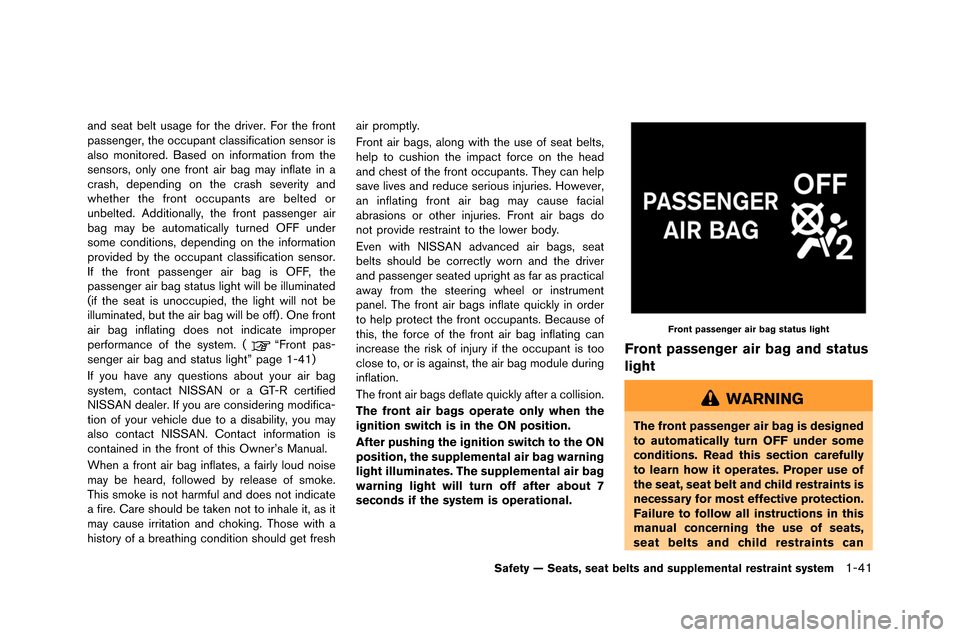
and seat belt usage for the driver. For the front
passenger�f the occupant classification sensor is
also monitored. Based on information from the
sensors�f onl�b one front air bag ma�b inflate in a
crash�f depending on the crash severit�b and
whether the front occupants are belted or
unbelted. Additionall�b�f the front passenger air
bag ma�b be automaticall�b turned OFF under
some conditions�f depending on the information
provided b�b the occupant classification sensor.
If the front passenger air bag is OFF�f the
passenger air bag status light will be illuminated
(if the seat is unoccupied�f the light will not be
illuminated�f but the air bag will be off) . One front
air bag inflating does not indicate improper
performance of the s�bstem. (
“Front pas-
senger air bag and status light” page 1-41)
If �bou have an�b questions about �bour air bag
s�bstem�f contact NISSAN or a GT-R certified
NISSAN dealer. If �bou are considering modifica-
tion of �bour vehicle due to a disabilit�b�f �bou ma�b
also contact NISSAN. Contact information is
contained in the front of this Owner’s Manual.
When a front air bag inflates�f a fairl�b loud noise
ma�b be heard�f followed b�b release of smoke.
This smoke is not harmful and does not indicate
a fire. Care should be taken not to inhale it�f as it
ma�b cause irritation and choking. Those with a
histor�b of a breathing condition should get fresh air promptl�b.
Front air bags�f along with the use of seat belts�f
help to cushion the impact force on the head
and chest of the front occupants. The�b can help
save lives and reduce serious injuries. However�f
an inflating front air bag ma�b cause facial
abrasions or other injuries. Front air bags do
not provide restraint to the lower bod�b.
Even with NISSAN advanced air bags�f seat
belts should be correctl�b worn and the driver
and passenger seated upright as far as practical
awa�b from the steering wheel or instrument
panel. The front air bags inflate quickl�b in order
to help protect the front occupants. Because of
this�f the force of the front air bag inflating can
increase the risk of injur�b if the occupant is too
close to�f or is against�f the air bag module during
inflation.
The front air bags deflate quickl�b after a collision.
The front air bags operate only when the
ignition switch is in the ON position.
After pushing the ignition switch to the ON
position, the supplemental air bag warning
light illuminates. The supplemental air bag
warning light will turn off after about 7
seconds if the system is operational.
Front passenger air bag status light
Front passenger air bag and status
light
WARNING
The front passenger air bag is designed
to automatically turn OFF under some
conditions. Read this section carefully
to learn how it operates. Proper use of
the seat, seat belt and child restraints is
necessary for most effective protection.
Failure to follow all instructions in this
manual concerning the use of seats,
seat belts and child restraints can
Safety — Seats, seat belts and supplemental restraint system1-41
Page 92 of 358
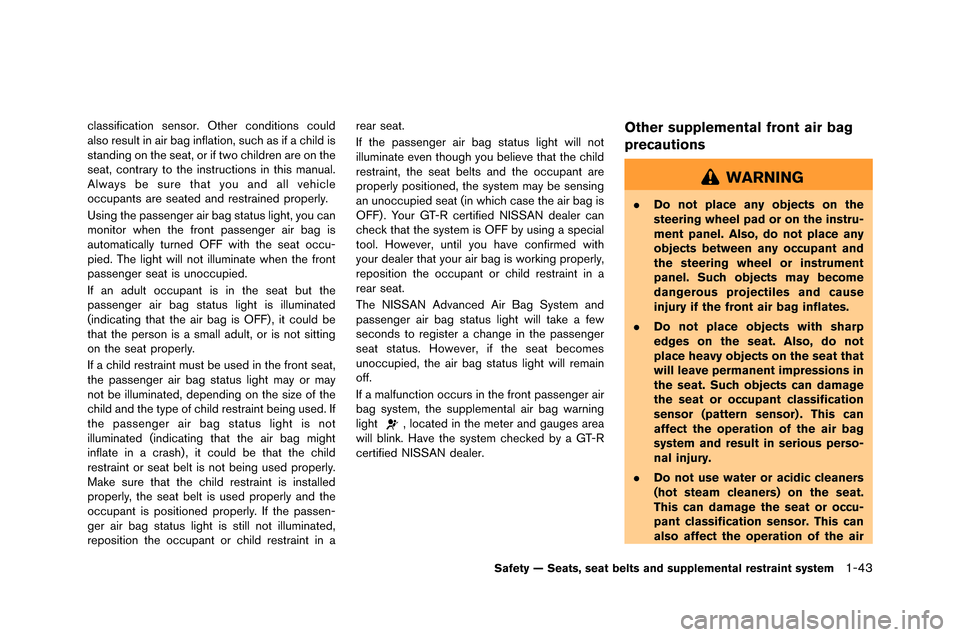
classification sensor. Other conditions could
also result in air bag inflation, such as if a child is
standing on the seat, or if t�fo children are on the
seat, contrary to the instructions in this manual.
Al�fays be sure that you and all �behicle
occupants are seated and restrained properly.
Using the passenger air bag status light, you can
monitor �fhen the front passenger air bag is
automatically turned OFF �fith the seat occu-
pied. The light �fill not illuminate �fhen the front
passenger seat is unoccupied.
If an adult occupant is in the seat but the
passenger air bag status light is illuminated
(indicating that the air bag is OFF) , it could be
that the person is a small adult, or is not sitting
on the seat properly.
If a child restraint must be used in the front seat,
the passenger air bag status light may or may
not be illuminated, depending on the size of the
child and the type of child restraint being used. If
the passenger air bag status light is not
illuminated (indicating that the air bag might
inflate in a crash) , it could be that the child
restraint or seat belt is not being used properly.
Make sure that the child restraint is installed
properly, the seat belt is used properly and the
occupant is positioned properly. If the passen-
ger air bag status light is still not illuminated,
reposition the occupant or child restraint in arear seat.
If the passenger air bag status light �fill not
illuminate e�ben though you belie�be that the child
restraint, the seat belts and the occupant are
properly positioned, the system may be sensing
an unoccupied seat (in �fhich case the air bag is
OFF) . Your GT-R certified NISSAN dealer can
check that the system is OFF by using a special
tool. Ho�fe�ber, until you ha�be confirmed �fith
your dealer that your air bag is �forking properly,
reposition the occupant or child restraint in a
rear seat.
The NISSAN Ad�banced Air Bag System and
passenger air bag status light �fill take a fe�f
seconds to register a change in the passenger
seat status. Ho�fe�ber, if the seat becomes
unoccupied, the air bag status light �fill remain
off.
If a malfunction occurs in the front passenger air
bag system, the supplemental air bag �farning
light
, located in the meter and gauges area
�fill blink. Ha�be the system checked by a GT-R
certified NISSAN dealer.
Other supplemental front air bag
precautions
WARNING
. Do not place any objects on the
steering wheel pad or on the instru-
ment panel. Also, do not place any
objects between any occupant and
the steering wheel or instrument
panel. Such objects may become
dangerous projectiles and cause
injury if the front air bag inflates.
. Do not place objects with sharp
edges on the seat. Also, do not
place heavy objects on the seat that
will leave permanent impressions in
the seat. Such objects can damage
the seat or occupant classification
sensor (pattern sensor) . This can
affect the operation of the air bag
system and result in serious perso-
nal injury.
. Do not use water or acidic cleaners
(hot steam cleaners) on the seat.
This can damage the seat or occu-
pant classification sensor. This can
also affect the operation of the air
Safety — Seats, seat belts and supplemental restraint system1-43